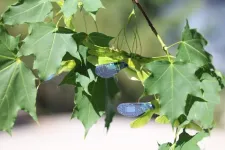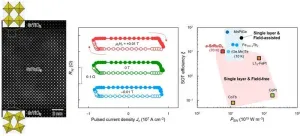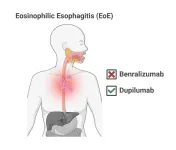(Press-News.org)
Ammonites were not in decline before their extinction, scientists have found.
The marine molluscs with coiled shells and one of palaeontology’s great icons flourished in Earth’s oceans for more than 350 million years until they died out during the same chance event that wiped out the dinosaurs 66 million years ago.
Some palaeontologists have argued that their demise was inevitable and that ammonite diversity was decreasing long before they went extinct at the end of the Cretaceous.
However new research, published today in Nature Communications and led by palaeontologists at the University of Bristol, shows that their fate was not set in stone. Instead, the final chapter in ammonite evolutionary history is more complex.
“Understanding how and why biodiversity has changed through time is very challenging,” said lead author Dr Joseph Flannery-Sutherland. “The fossil record tells us some of the story, but it is often an unreliable narrator. Patterns of diversity can just reflect patterns of sampling, essentially where and when we have found new fossil species, rather than actual biological history.
“Analysing the existing Late Cretaceous ammonite fossil record as though it were the complete, global story is probably why previous researchers have thought they were in long-term ecological decline.”
To overcome this issue, the team assembled a new database of Late Cretaceous ammonite fossils to help fill in the sampling gaps in their record. “We drew on museum collections to provide new sources of specimens rather than just relying on what had already been published,” said co-author Cameron Crossan, a 2023 graduate of the University of Bristol’s Palaeobiology MSc programme. “This way we could be sure that we were getting a more accurate picture of their biodiversity prior to their total extinction.”
Using their database, the team then analysed how ammonite speciation and extinction rates varied in different parts of the globe. If ammonites were in decline through the Late Cretaceous, then their extinction rates would have been generally higher than their speciation rates wherever the team looked. What the team instead found was that the balance of speciation and extinction changed both through geological time and between different geographic regions.
“These differences in ammonoid diversification around the world is a crucial part of why their Late Cretaceous story has been misunderstood,” said senior author Dr James Witts of the Natural History Museum, London. “Their fossil record in parts of North America is very well sampled, but if you looked at this alone then you might think that they were struggling, while they were actually flourishing in other regions. Their extinction really was a chance event and not an inevitable outcome.”
To find out what was responsible for the continued success of ammonites through the Late Cretaceous, the team looked at potential factors might have caused their diversity to change through time. They were particularly interested in whether their speciation and extinction rates were driven mainly by environmental conditions like ocean temperature and sea level (the Court Jester Hypothesis), or by biological processes like pressure from predators and competition between ammonites themselves (the Red Queen Hypothesis).
“What we found was that the causes of ammonite speciation and extinction were as geographically varied as the rates themselves,” said co-author Dr Corinne Myers of the University of New Mexico. “You couldn’t just look at their total fossil record and say that their diversity was driven entirely by changing temperature, for example. It was more complex than that and depended on where in the world they were living.”
“Palaeontologists are frequently fans of silver bullet narratives for what drove changes in a group’s fossil diversity, but our work shows that things are not always so straightforward,” Dr Flannery Sutherland concluded. “We can’t necessarily trust global fossil datasets and need to analyse them at regional scales. This way we can capture a much more nuanced picture of how diversity changed across space and through time, which also shows how variation in the balance of Red Queen versus Court Jester effects shaped these changes.”
Ammonites basking under the Late Cretaceous sun. Artwork by Callum Pursall (@cpursall on X)
The paper:
‘Late Cretaceous ammonoids show that drivers of diversification are regionally heterogeneous’ by Joseph Flannery-Sutherland, Cameron Crossan, Corinne Myers, Austin Hendy, Neil Landman and James Witts in Nature Communications.
END
Being nursed by a single parent could be an evolutionary strategy to curb the spread of harmful microbes in mammals, according to a novel theory developed by mathematicians.
The rainforests of Malaysia are home to the only known case of a wild male mammal that produces milk. The Dayak fruit bat is a vanishingly rare case of male milk production, despite the fact that the potential for breastfeeding remains in place in most male mammals.
In the 1970s, evolutionary theorists posited that the near absence of ...
Los Angeles, CA (June 27, 2024) —A new study published in the journal Nature Communications led by paleontologists at the University of Bristol along with a team of international researchers, including Dr. Austin Hendy, Curator of Invertebrate Paleontology at the Natural History Museum of Los Angeles County, finds that instead of fizzling out ahead of their extinction, ammonoids were still going strong across the globe in the Late Cretaceous. Made possible by museum collections, the new study compared their diversity across the globe just prior to extinction, unearthing the complex evolutionary history ...
Embargoed until 4am EDT Cleveland, OH (Thursday, June 27, 2024) – Cleveland Clinic and app developer FitNow, Inc. have launched the Cleveland Clinic Diet app, which offers health and diet advice built upon evidence-based nutrition science and clinical success, paired with a comprehensive food and fitness tracker.
The app provides individualized guided support with the input of Cleveland Clinic health experts to help users make sustainable changes to their lifestyle and dietary habits for better health and well-being.
“We know that health is about far more than just weight. ...
Researchers from Tampere University, Finland, and the University of Pittsburgh, USA, have developed a tiny robot replicating the aerial dance of falling maple seeds. In the future, this robot could be used for real-time environmental monitoring or delivery of small samples even in inaccessible terrain such as deserts, mountains or cliffs, or the open sea. This technology could be a game changer for fields such as search-and-rescue, endangered species studies, or infrastructure monitoring.
At Tampere University, Professor Hao Zeng and Doctoral Researcher Jianfeng Yang ...
Bottom Line: Patients with treatment-refractory cancers who received eligibility and testing waivers to participate in a large basket/umbrella oncology trial had similar rates of clinical benefit and adverse events as patients who participated in the trial without waivers.
Journal in Which the Study was Published: Clinical Cancer Research, a journal of the American Association for Cancer Research (AACR)
Author: Hans Gelderblom, MD, senior author of the study and chair of the Department of Medical Oncology at the Leiden University Medical Center in the Netherlands
Background: Eligibility requirements ...
Psilocybin mushrooms are the psychedelic substance most often used in the U.S., with its popularity outpacing other psychedelic drugs such as MDMA (known as ecstasy), according to a new RAND report.
Based on a new national survey, researchers found that about 12% of respondents reported using psilocybin at some point over their lives and 3.1% reported using the substance over the past year. An estimated 8 million American adults used psilocybin in 2023.
Psychedelic substances such as psilocybin mushrooms and MDMA long have been touted as holding promise for treating various mental ...
Arlington, Va. — June 27, 2024 — A new study published today in the American Journal of Infection Control (AJIC) describes the outcome of a new approach to testing for Clostridioides difficile (C. diff) guided by the principles of diagnostic stewardship. At Memorial Healthcare System in Hollywood, Fla., revised rules for when C. diff tests could be ordered helped to reduce inappropriate testing by 20%, which in turn can help rein in the overtreatment of patients.
C. diff is a common and potentially dangerous gastrointestinal pathogen, often linked to healthcare-associated infections ...
Like the flutter of a butterfly's wings, sometimes small and minute changes can lead to big and unexpected results and changes in our lives. Recently, a team of researchers at Pohang University of Science and Technology (POSTECH) made a very small change to develop a material called “spin-orbit torque (SOT),” which is a hot topic in next-generation DRAM memory.
This research team, led by Professor Daesu Lee and Yongjoo Jo, a PhD candidate, from the Department of Physics and Professor Si-Young ...
Machines have evolved to meet the demands of daily life and industrial use, with molecular-scale devices often exhibiting improved functionalities and mechanical movements. However, mastering the control of mechanics within solid-state molecular structures remains a significant challenge.
Researchers at Ulsan National Institute of Science and Technology (UNIST), South Korea have made a groundbreaking discovery that could pave the way for revolutionary advancements in data storage and beyond. Led by Professor Wonyoung Choe in the Department of Chemistry at UNIST), a team of scientists has developed zeolitic imidazolate frameworks (ZIFs) that mimic intricate machines. These molecular-scale ...
Despite high hopes, a drug that wipes out the namesake cell type associated with the disease eosinophilic esophagitis (EoE) doesn’t make patients feel better and doesn’t reverse tissue damage in their throats.
Meanwhile, data show that a different drug that had previously been approved for use in adults and teens with EoE is also safe and effective for children under 12 who weigh at least 15 kg (about 33 pounds).
The results of these clinical trials—plus an accompanying editorial—appear in the June 17, 2024, edition of The New England Journal of Medicine.
“Together, these ...








